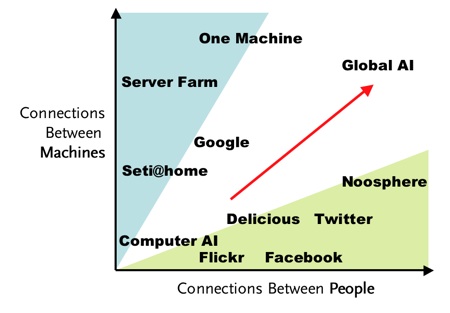Two Strands of Connectionsim
One strand of massive connectionism is currently called social media. The goal is to connect everybody to everybody else in as many different arrangements as possible. Twitter, Flickr, Facebook, Digg, Delicious, Yahoo Answers – the whole 10,000 strong universe of Web 2.0 sites employ various webs of humans to accomplish new things. In this regime, humans are the nodes. They generate the signals.
The other strand of massive connectionism relies on a massive number of machines, CPUs and computer transistors linked together in as many ways as possible to get things done. For example, gigantic server farms, data centers, and telecommunication networks. At the extreme level we’d have to include the mega-network of the One Machine consisting of all cell phones, PDAs, PCs, routers, wi-fi spots, satellite links, and so on. On this side, the signals at each node are generated by machines.

Of course on the side of “people connectionism” the information is still transmitted by machines (unlike the traditional social connectionism at a large conference, ancient town, or say, Burning Man). But there is a blank white space between these two realms, where both humans and machines could be tightly and massively interlinked – but are not yet.
This new territory can best be illustrated by the far-right top extreme where both sides meet in the center (red arrow) – the area where we have maximum machine connection and maximum human connection. This overlap or convergence space would be the emerging global superorganism. The entity represented by this space is not just the One Machine composed of all other machines connected together. Nor is it the Noosphere of all human minds connected into one large supermind. Rather it is the vigorous hybrid of both all human minds and all artificial minds linked together. It is the pan-mind. At this juncture the nodes are anything that generates a signal – either humans or machines.
We have a small sense of this mix in Google, which relies on both massive machine connectionism and massive human work in clicking on links. But we can easily imagine other arrangements where more of all the planet’s technology is linked up and more human behavior and thinking as well.
This cyborgian white space is also where most semantic web efforts are aimed. The idea of the semantic web is to make human connectionism readable by the machine side (and vice versa) so that both webs can work in concert. Semantic web technologies are a bridge or translation channel between the two sides of connectionism. All human thoughts, actions, and memories want to be deciphered, structured by machines, and machine structures understandable by humans.
The big white space and red arrow is what I think of as Web 3.0 and onward. It will take many decades to explore. And of course there is plenty of room for all kinds of innovations on either side as well. From this perspective, we’ve just begun.
You are not too late!
I am grateful to Nova Spivack for the inspiration of this chart. He would put his own semantic web startup, Twine, along the red arrow in the center. (Twine is a combination social bookmarking service, recommendation engine, and smart archive.)


